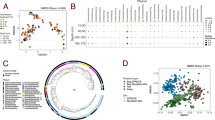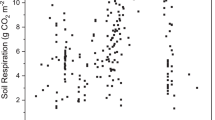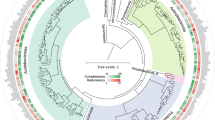Abstract
Ombrotrophic bogs accumulate large stores of soil carbon that eventually decompose to carbon dioxide and methane. Carbon accumulates because Sphagnum mosses slow microbial carbon decomposition processes, leading to the production of labile intermediate compounds. Acetate is a major product of Sphagnum degradation, yet rates of hydrogenotrophic methanogenesis far exceed rates of aceticlastic methanogenesis, suggesting that alternative acetate mineralization processes exist. Two possible explanations are aerobic respiration and anaerobic respiration via humic acids as electron acceptors. While these processes have been widely observed, microbial community interactions linking Sphagnum degradation and acetate mineralization remain cryptic. In this work, we use ordination and network analysis of functional genes from 110 globally distributed peatland metagenomes to identify conserved metabolic pathways in Sphagnum bogs. We then use metagenome-assembled genomes (MAGs) from McLean Bog, a Sphagnum bog in New York State, as a local case study to reconstruct pathways of Sphagnum degradation and acetate mineralization. We describe metabolically flexible Acidobacteriota MAGs that contain all genes to completely degrade Sphagnum cell wall sugars under both aerobic and anaerobic conditions. Finally, we propose a hypothetical model of acetate oxidation driven by changes in peat redox potential that explain how bogs may circumvent aceticlastic methanogenesis through aerobic and humics-driven respiration.
Similar content being viewed by others
Log in or create a free account to read this content
Gain free access to this article, as well as selected content from this journal and more on nature.com
or
References
Amesbury MJ, Gallego-Sala A, Loisel J. Peatlands as prolific carbon sinks. Nat Geosci. 2019;12:880–1.
Rydin H, Jeglum J. The biology of peatlands. 2nd ed. New York: Oxford University Press; 2013.
Kremer C, Pettolino F, Bacic A, Drinnan A. Distribution of cell wall components in Sphagnum hyaline cells and in liverwort and hornwort elaters. Planta. 2004;219:1023–35.
Theander O. Studies on Sphagnum peat. III. A quantitative study on the carbohydrate constituents of Sphagnum mosses and Sphagnum peat. Acta Chem Scand. 1954;8:989–1000.
Ballance S, Borsheim KY, Inngjerdingen K, Paulsen BS, Christensen BE. A re-examination and partial characterisation of polysaccharides released by mild acid hydrolysis from the chlorite-treated leaves of Sphagnum papillosum. Carbohydr Polym. 2007;67:104–15.
Painter TJ. Residues of D-lyxo-5-hexosulopyranuronic acid in Sphagnum holocellulose, and their role in cross-linking. Carbohydr Res. 1983;124:C18–C21.
Bartels D, Baumann A, Maeder M, Geske T, Heise EM, von Schwartzenberg K, et al. Evolution of plant cell wall: arabinogalactan-proteins from three moss genera show structural differences compared to seed plants. Carbohydr Polym. 2017;163:227–35.
Woodcroft BJ, Singleton CM, Boyd JA, Evans PN, Emerson JB, Zayed AAF, et al. Genome-centric view of carbon processing in thawing permafrost. Nature. 2018;560:49–54.
Ivanova AA, Wegner C-E, Kim Y, Liesack W, Dedysh SN. Identification of microbial populations driving biopolymer degradation in acidic peatlands by metatranscriptomic analysis. Mol Ecol. 2016;25:4818–35.
Duddleston KN, Kinney MA, Kiene RP, Hines ME. Anaerobic microbial biogeochemistry in a northern bog: acetate as a dominant metabolic end product. Glob Biogeochem Cycles. 2002;16:11–1-11–9.
Ye R, Jin Q, Bohannan B, Keller JK, McAllister SA, Bridgham SD. pH controls over anaerobic carbon mineralization, the efficiency of methane production, and methanogenic pathways in peatlands across an ombrotrophic-minerotrophic gradient. Soil Biol Biochem. 2012;54:36–47.
van Beelen P, Wouterse MJ, Masselink MJ, Spijker J, Mesman M. The application of a simplified method to map the aerobic acetate mineralization rates at the groundwater table of the Netherlands. J Contam Hydrol. 2011;122:86–95.
Conrad R. Importance of hydrogenotrophic, aceticlastic and methylotrophic methanogenesis for methane production in terrestrial, aquatic and other anoxic environments: a mini review. Pedosphere. 2020;30:25–39.
Walpen N, Getzinger GJ, Schroth MH, Sander M. Electron-donating phenolic and electron-accepting quinone moieties in peat dissolved organic matter: quantities and redox transformations in the context of peat biogeochemistry. Environ Sci Technol. 2018;52:5236–45.
Dettling MD, Yavitt J, Zinder S. Control of organic carbon mineralization by alternative electron acceptors in four peatlands, central New York State, USA. Wetlands. 2006;26:917–27.
Keller JK, Bridgham SD. Pathways of anaerobic carbon cycling across an ombrotrophic-minerotrophic peatland gradient. Limnol Oceanogr. 2007;52:96–107.
Keller JK, Takagi KK. Solid-phase organic matter reduction regulates anaerobic decomposition in bog soil. Ecosphere. 2013;4:1–12.
Keller JK, Weisenhorn PB, Megonigal JP. Humic acids as electron acceptors in wetland decomposition. Soil Biol Biochem. 2009;41:1518–22.
Yavitt JB, Seidman-Zager M. Methanogenic conditions in northern peat soils. Geomicrobiol J. 2006;23:119–27.
He S, Lau MP, Linz AM, Roden EE, McMahon KD. Extracellular electron transfer may be an overlooked contribution to pelagic respiration in humic-rich freshwater lakes. mSphere. 2019;4:1–8.
Lovley DR, Coates JD, Blunt-Harris EL, Phillips EJ, Woodward JC. Humic substances as electron acceptors for microbial respiration. Nature. 1996;382:445–8.
Stams AJM, De Bok FAM, Plugge CM, Van Eekert MHA, Dolfing J, Schraa G. Exocellular electron transfer in anaerobic microbial communities. Environ Microbiol. 2006;8:371–82.
Klupfel L, Piepenbrock A, Kappler A, Sander M. Humic substances as fully regenerable electron acceptors in recurrently anoxic environments. Nat Geosci. 2014;7:195–200.
Bräuer SL, Yavitt JB, Zinder SH. Methanogenesis in McLean Bog, an acidic peat bog in upstate New York: stimulation by H2/CO2 in the presence of rifampicin, or by low concentrations of acetate. Geomicrobiol J. 2004;21:433–43.
Cadillo-Quiroz H, Brauer S, Yashiro E, Sun C, Yavitt J, Zinder S. Vertical profiles of methanogenesis and methanogens in two contrasting acidic peatlands in central New York State, USA. Environ Microbiol. 2006;8:1428–40.
Kotsyurbenko O, Chin K, Glagolev M, Stubner S, Simankova M, Nozhevnikova A, et al. Acetoclastic and hydrogenotrophic methane production and methanogenic populations in an acidic West-Siberian pear bog. Environ Microbiol. 2004;6:1159–73.
Lai DYF. Methane dynamics in northern peatlands: a review. Pedosphere. 2009;19:409–21.
Xu XF, Elias DA, Graham DE, Phelps TJ, Carroll SL, Wullschleger SD, et al. A microbial functional group-based module for simulating methane production and consumption: application to an inbucated permafrost soil. J Geophys Res Biogeosci. 2015;120:1315–33.
Chen I-MA, Markowitz VM, Chu K, Palaniappan K, Szeto E, Pillay M, et al. IMG/M: integrated genome and metagenome comparative data analysis system. Nucleic Acids Res. 2017;45:D507–16.
Langfelder P, Horvath S. WGCNA: an R package for weighted correlation network analysis. BMC Bioinformat. 2008;9:559.
Langfelder P, Horvath S. Eigengene networks for studying the relationships between co-expression modules. BMC Syst Biol. 2007;1:54.
Sun CL, Brauer SL, Cadillo-Quiroz H, Zinder SH, Yavitt JB. Seasonal changes in methanogenesis and methanogenic community in three peatlands, New York State. Front Microbiol. 2012;3:81.
Osvald H. Vegetation and stratigraphy of peatlands in North America. Uppsala: Acta Universitatis Upsaliensis; 1970.
Pepe-Ranney C, Campbell AN, Koechli CN, Berthrong S, Buckley DH. Unearthing the ecology of soil microorganisms using a high resolution DNA-SIP approach to explore cellulose and xylose metabolism in soil. Front Microbiol. 2016;7:703.
Nurk S, Meleshko D, Korobeynikov A, Pevzner PA. metaSPAdes: a new versatile metagenomic assembler. Genome Res. 2017;27:824–34.
Ondov BD, Treangen TJ, Melsted P, Mallonee AB, Bergman NH, Koren S, et al. Mash: fast genome and metagenome distance estimation using MinHash. Genome Biol. 2016;17:132.
Kang D, Froula J, Egan R, Wang Z. MetaBAT, an efficient tool for accurately reconstructing single genomes from complex microbial communities. PeerJ. 2015;3:e1165.
Parks DH, Imelfort M, Skennerton CT, Hugenholtz P, Tyson GW. CheckM: assessing the quality of microbial genomes recovered from isolates, single cells, and metagenomes. Genome Res. 2015;25:1043–55.
Bowers RM, Kyrpides NC, Stepanauskas R, Harmon-Smith M, Doud D, Reddy TBK, et al. Minimum information about a single amplified genome (MISAG) and a metagenome-assembled genome (MIMAG) of bacteria and archaea. Nat Biotechnol. 2017;35:725.
Segata N, Börnigen D, Morgan XC, Huttenhower C. PhyloPhlAn is a new method for improved phylogenetic and taxonomic placement of microbes. Nat Commun. 2013;4:2304.
Buchfink B, Xie C, Huson DH. Fast and sensitive protein alignment using DIAMOND. Nat Methods. 2014;12:59.
Parks DH, Chuvochina M, Waite DW, Rinke C, Skarshewski A, Chaumeil P-A, et al. A standardized bacterial taxonomy based on genome phylogeny substantially revises the tree of life. Nat Biotechnol. 2018;36:996–1004.
Rodriguez-R LM, Tsementzi D, Luo C, Konstantinidis KT. Iterative substractive binning of freshwater chronoseries metagenomes identifies over 400 novel species and their ecologic preferences. Environ Microbiol. 2020;22:3394–412.
Langmead B, Salzberg SL. Fast gapped-read alignment with Bowtie 2. Nat Methods. 2012;9:357–9.
Quinlan AR, Hall IM. BEDTools: a flexible suite of utilities for comparing genomic features. Bioinformatics. 2010;26:841–2.
Rodriguez-R LM, Konstantinidis KT. The enveomics collection: a toolbox for specialized analyses of microbial genomes and metagenomes. PeerJ Prepr. 2016;4:e1900v1.
Nayfach S, Pollard KS. Average genome size estimation improves comparative metagenomics and sheds light on the functional ecology of the human microbiome. Genome Biol. 2015;16:51.
Zalman C, Keller JK, Tfaily M, Kolton M, Pfeifer-Meister L, Wilson RM, et al. Small differences in ombrotrophy control regional-scale variation in methane cycling among Sphagnum-dominated peatlands. Biogeochemistry. 2018;139:155–77.
Williams CJ, Yavitt JB. Botanical composition of peat and degree of peat decomposition in three temperate peatlands. Ecoscience. 2003;10:85–95.
Dedysh SN. Cultivating uncultured bacteria from northern wetlands: knowledge gained and remaining gaps. Front Microbiol. 2011;2:184.
Hattori S. Syntrophic acetate-oxidizing microbes in methanogenic environments. Microbes Environ. 2008;23:118–27.
Hines ME, Duddleson KN, Kiene RP. Carbon flow to acetate and C1 compounds in northern wetlands. Geophys Res Lett. 2001;28:4251–4.
Karakashev D, Batstone DJ, Trably E, Angelidaki I. Acetate oxidation is the dominant methanogenic pathway from acetate in the absence of Methanosaetaceae. Appl Environ Microbiol. 2006;72:5138–41.
Cervantes FJ, van der Velde S, Lettinga G, Field JA. Competition between methanogenesis and quinone respiration for ecologically important substrates in anaerobic consortia. FEMS Microbiol Ecol. 2000;34:161–71.
Cervantes FJ, Gutierrez CH, Lopez KY, Estrada-Alvarado MI, Meza-Escalante AC, Texier AC, et al. Contribution of quinone-reducing microorganisms to the anaerobic biodegradation of organic compounds under different redox conditions. Biodegradation. 2008;19:235–46.
Lokshina LY, Vavilin VA, Kettunen RH, Rintala JA, Holliger C, Nozhevnikova AN. Evaluation of kinetic coefficients using integrated monod and haldane models for low-temperature acetoclastic methanogenesis. Water Res. 2001;35:2913–22.
Kotsyurbenko OR, Friedrich MW, Simankova MV, Nozhevnikova AN, Golyshin PN, Timmis KN, et al. Shift from acetoclastic to H2-dependent methanogenesis in a West Siberain peat bog at low pH values and isolation of an acidophilic Methanobacterium strain. Appl Environ Microbiol. 2007;73:2344–8.
Schmidt O, Hink L, Horn M, Drake H. Peat: home to novel syntrophic species that feed acetate- and hydrogen-scavenging methanogens. ISME J. 2016;10:1954–66.
Wolfe AJ. The acetate switch. Microbiol Mol Biol Rev. 2005;69:12–50.
Starai VJ, Escalante-Semerena JC. Acetyl-coenzyme A synthetase (AMP forming). Cell Mol Life Sci. 2004;61:2020–30.
Pankratov TA, Dedysh SN, Zavarzin GA. The leading role of Actinobacteria in aerobic cellulose degradation in Sphagnum peat bogs. Dokl Biol Sci. 2006;410:428–30.
Mannisto M, Ganzert L, Tjirola M, Haggblom MM, Stark S. Do shifts in life strategies explain microbial community responses to increasing nitrogen in tundra soil? Soil Biol Biochem. 2016;96:216–28.
Kang H, Kwon MJ, Kim S, Lee S, Jones TG, Johncock AC, et al. Biologically driven DOC release from peatlands during recovery from acidification. Nat Commun. 2018;9:3807.
Dedysh SN, Dunfield PF. Beijerinckiaceae. In: Whitman WB, editor. Bergey’s manual of systematics of archaea and bacteria. Hoboken, NJ: John Wiley & Sons, Inc.; 2016. p. 1–4.
Acknowledgements
The authors would like to thank Tamar Barkay, Hinsby Cadillo-Quiroz, and Janet Jansson for their permission to include their unpublished metagenomes in this study. This work was supported by a microbial/metagenome project (CSP 503730) through the U.S. Department of Energy Joint Genome Institute, a DOE Office of Science User Facility, which is supported by the Office of Science of the U.S. Department of Energy under Contract No. DE-AC02–05CH11231.
Author information
Authors and Affiliations
Corresponding author
Ethics declarations
Conflict of interest
The authors declare that they have no conflict of interest.
Additional information
Publisher’s note Springer Nature remains neutral with regard to jurisdictional claims in published maps and institutional affiliations.
Supplementary information
Rights and permissions
About this article
Cite this article
St. James, A.R., Yavitt, J.B., Zinder, S.H. et al. Linking microbial Sphagnum degradation and acetate mineralization in acidic peat bogs: from global insights to a genome-centric case study. ISME J 15, 293–303 (2021). https://doi.org/10.1038/s41396-020-00782-0
Received:
Revised:
Accepted:
Published:
Issue date:
DOI: https://doi.org/10.1038/s41396-020-00782-0
This article is cited by
-
Northern peatland microbial communities exhibit resistance to warming and acquire electron acceptors from soil organic matter
Nature Communications (2025)
-
Integrating Decomposers, Methane-Cycling Microbes and Ecosystem Carbon Fluxes Along a Peatland Successional Gradient in a Land Uplift Region
Ecosystems (2022)
-
Grazing by Tibetan Sheep Enhances Soil Bacterial and Fungal Diversity in Cold Season Pastures of Alpine Meadows on the Northern Qinghai–Tibetan Plateau
Journal of Soil Science and Plant Nutrition (2022)
-
Relationship Between Peat Type and Microbial Ecology in Sphagnum-Containing Peatlands of the Adirondack Mountains, NY, USA
Microbial Ecology (2021)



